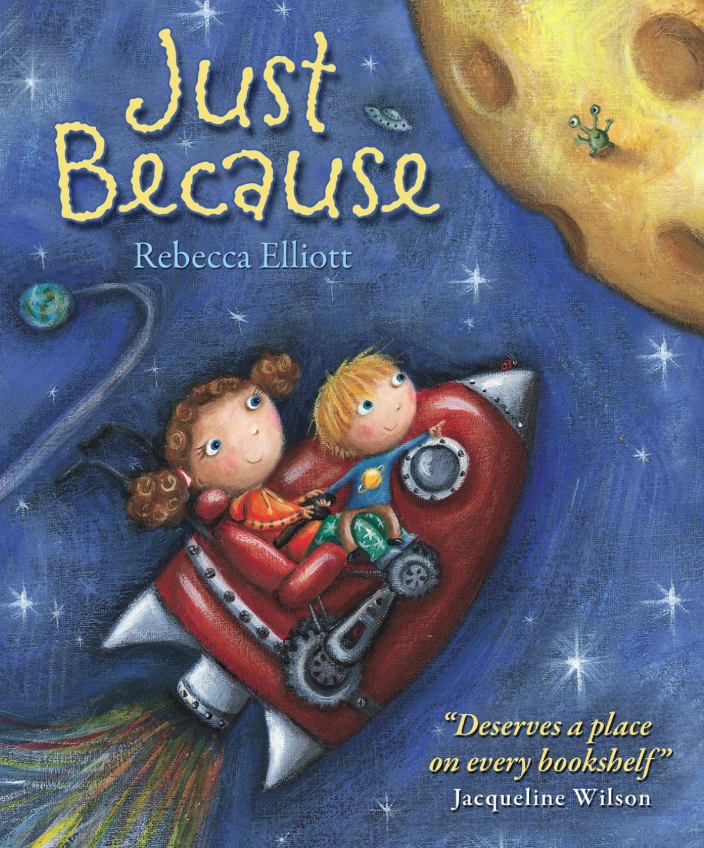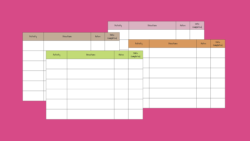
Listen to my interview with Jam Gamble, or read a full transcript here.
I can remember the first time I taught students with disabilities. I was teaching sixth grade, and twelve students with IEPs had been placed in a single class period with me. Despite the fact that I’d had one whole 3-credit college course devoted entirely to special education, I was absolutely clueless. I mean, I had seen the students’ IEPs, but I didn’t really know how to interpret them. I was introduced to Kathy, the resource teacher who would accompany these students to class every day, but I wasn’t sure what her role was or what shape our relationship was supposed to take.
And needless to say, that year was an absolute train wreck. I know I didn’t serve those twelve kids well, and the remaining students also suffered, because I knew nothing about how to manage a class with such a wide range of abilities and needs.
I can only imagine how different things could have been if I’d known someone like Jam Gamble. I just discovered Jam—short for Jahmeelah—on Periscope a few weeks ago. She was talking about how she dealt with a student’s misbehavior one particular day, and just listening to the love in her voice and the careful way she handled this student’s feelings told me she was the kind of teacher I wanted to know. Once I realized her work focused primarily on special ed, an area I haven’t given nearly enough attention to on this site, I knew I had to have her on the podcast.

Ms. Jam is a developmental services worker in Toronto, Ontario. She supports students with disabilities, holds workshops, consults, and hosts her own TV show called A Voice for All, which focuses on promoting disability awareness within the greater Toronto community.
When discussing possible topics for our interview, Jam and I talked about how many general ed teachers feel inadequately prepared to serve the needs of students with disabilities. Despite this lack of preparation, every year more teachers are likely to have these students in their classrooms. Because Jam spends every day doing this kind of work, we decided to have her share some ways general ed teachers could make their classrooms more welcoming for students with IEPs.
1. Express your fears and concerns.
When we think about making our classrooms more accessible, we tend to think primarily in terms of the physical space. “You could have the most accessible classroom in terms of space and lighting,” Gamble says, “but if you don’t have an accessible attitude, your classroom’s not accessible.”
She believes “inaccessible” attitudes stem from fear, from the discomfort of being assigned to work with a child with a disability and feeling ill-equipped to do so. She says the key to breaking through this is to admit your fears and talk to someone who can help. “You have to admit if you’re nervous. You have to admit if you have worries. Then you can find the right people who could help you get over those fears.”
And who are those people? “First and foremost,” Gamble says, “talk to the parents. Ask them about their child. How was their summer? How was school last year? What were goals that you wanted to see manifest last year but didn’t manifest that we could focus on this year? What are things they’re doing outside the school that we could incorporate into their lessons? Questions like that give you so much information that you can take and run with.”
The other person to confide in is the support specialist at your school. This was something I didn’t really do as a general ed classroom teacher, and now I can’t even imagine why. “This is someone who is there for the sole purpose of that student, and they understand a lot about inclusion and integration and program planning for this child,” Gamble says. “Why wouldn’t you talk to that person to get that juicy information that you need?”
2. Consult with your specialists. Regularly.
In my own experience as a classroom teacher, I rarely met with the support specialists unless I was having a problem. I didn’t meet with them proactively. That was a mistake; I didn’t fully understand what they had to offer.
Gamble says classroom teachers who make this effort, who reach out to the specialists in their building, get a lot in return. “I absolutely love some of the past teachers I’ve worked with who have come to me to like, ‘I’ll be honest with you. I don’t know where to begin. Can we talk? Tell me what your skills are.’ And I’m like, ‘Yes. Oh my goodness, yes.'”
Because special ed teachers’ resumes are not on display, classroom teachers may underestimate their skills and expertise. “Unless you ask me,” Gamble says, “you wouldn’t know I have supported people with disabilities from birth to seniors. I have a wide range of experience in terms of who I’ve supported, whether they’re lower functioning or higher functioning, someone who’s dependent or independent. I have a wide range of experience when it comes to seizures. I’ve worked with children who are nonverbal. I’ve worked with children who are verbal. I’ve worked with people who have echolalia. I’ve worked with children who have fears and phobias. I’ve worked with all these different people that I’ve taken all my personal experiences from them, and I’ve put it into this one big recipe book that a child could come in, and I could go, boom. I know exactly what to do.”

3. Design activities that challenge everyone.
Much of the time, classroom work will need to be modified for the student with an IEP. But if we occasionally flip this—creating activities that truly level the playing field—we can give that student access while also letting others experience the world the way that student does.
“Once I had a student with a visual impairment,” Gamble says, “and we created a sensory challenge where everyone had to be blindfolded, and you had to touch different objects and try to guess what they were. We did a scavenger hunt around the classroom—’Four steps to the left. Three to the right. Stop. Put your arm in front of you.’—so they could experience what it was like to move around the world with a visual impairment.”
4. Recognize that parents struggle with their own discomfort and fear.
Teachers will be more successful in partnering with parents if they’re aware that parents may need emotional support. “Some of these parents just received a diagnosis,” Gamble explains, “so they’re going through their own guilt and denial and embarrassment and shame, and all those types of emotions.”
These emotions can manifest as behaviors that teachers might misinterpret. “I’ve had parents who are very silent. They don’t want to come to the meetings. When you do get them in for a meeting, they don’t have much to say…there’s a wall that’s up. They don’t seem like they want to engage.”
When encountering parents who present with challenging attitudes or behaviors, Gamble urges teachers to withhold judgment. “You have to look at the background story before you judge these parents,” she says. “And unfortunately, I’m seeing too much judging happening. We’re looking at their external behavior, and we’re not looking at why their behavior may be happening.”
She also recommends helping parents see how vital their role is. When Gamble talks with parents, she explicitly asks them for their help. “I go, ‘I need you. I need you to meet me halfway. I want you to be invested in this, because I’m invested in your child…if you really want me to do the magic I’m capable of doing, I need you in on this with me, and if there’s things that you’re scared about, if there’s things you’re unsure about, let’s get through this together.'”
5. Read books with students that promote diversity and inclusion.
Books are a powerful tool for building an inclusive classroom culture. Teachers should seek books for their classroom libraries that have characters with disabilities. They should also read and discuss them regularly as a class.
“We don’t have to wait until Autism Awareness Month or Down Syndrome Awareness Month,” Gamble says. “This needs to be a weekly thing that we talk about being different and promoting differences and celebrating it as a uniqueness and not something that we have to be cautious about.”
Below are two of Gamble’s favorite books for sharing with younger students, along with some other highly acclaimed books for a range of age groups.
This section contains Amazon Affiliate links. If you make a purchase through these, Cult of Pedagogy receives a small commission at no extra cost to you.
Other highly-rated books that promote inclusive thinking:
Share Your Thoughts
The posts on this site get better over time because of all the insightful comments shared by readers. If you are a general ed or special ed teacher, tell us what you’ve learned about making your classrooms more inclusive. Parents, share your stories about teachers that have made your child feel welcome. ♦
Where to Find Jam Gamble
Website: www.msjam.ca
Twitter: twitter.com/Iamjamgamble
Instagram: instagram.com/iamjamgamble
Join my mailing list and get weekly tips, tools, and inspiration all geared toward making your teaching more effective and fun. You’ll also get access to my members-only library of free resources, including my e-booklet, 20 Ways to Cut Your Grading Time in Half, which has helped thousands of teachers spend less time grading!












This is excellent content and I am glad to have access to it. I would also like to know how to better include these kids in my 6 week long exploratory foreign language class, that ALL kids are required to take. I have them for 1 hour a day for only 6 weeks in the entire year. (6,7,8 grades). Any thoughts?
Hi Linda!
So glad you enjoyed the podcast. If you can tell us more about the students perhaps I could offer some strategies.
Jam 🙂
This was a great blog post, but I almost didn’t read it because of the title. Students are always general education students first and are some are also served by special education. I think that mindset is crucial in a full inclusion school. I love how you pointed how how underutilized ed specialists are…they are, in fact, very skilled and they collaboration between the ed specialists and general education teachers is vital. I hope to see more posts on full inclusion from you. Thank you for this post!
Hey Christina,
I always struggle with titles. I am well aware of “person first” language, but have a hard time coming up with a title that conveys the topic of a post, but is short enough to be shared on social media. I am going to change this title to reflect person-first language and hope it doesn’t get cut off when it is shared! Thanks for the reminder.
You could drop the Creating a welcoming classroom and put just welcoming or integrating before the student with special needs.
Hi There, I love your commitment to person first language and your thoughtfulness about the term inclusion. I would like to suggest spreading the thoughts about language regarding “special needs.” There is a great video about how all people really just have human needs. https://youtu.be/kNMJaXuFuWQ
Thanks again for your blog.
Sherry,
Thanks for your positive feedback. I’ll be sure to share this with Jenn. Also, thanks for sharing this video!
Thank you Christina for pointing out the person first language! I felt the same way. Also, I have stopped using the word inclusion. Someone will tell me there is an inclusion classroom or school and I immediately wonder who is in the exclusion class or exclusion school. Have you ever seen this short video regarded integrated vs. inclusive education? https://www.youtube.com/watch?v=VIxVOhPq6i0
Barb, this is a wonderful video. I love her! I have just pinned this to my Special Education board on Pinterest so others will find it as well. So do you prefer the term “integrated” classroom? Or just no special terminology at all?
I really need info on intergrating special needs in a middle school classroom setting. Specifically, Language Arts suggestions and technical writing ideas. These classes see a huge disparity in abilities to maintain pace and contribute in at an appropriate skill level. I’ll be honest, I don’t think its always a good choice to all students to have such a gap in abilities in the same classroom. Everyone suffers. Its really ridiculous to have to meet the needs of 30 kids x 5 sections with hugely varying abilities. Ms. Jam MAGIC please!
Marcee! I totally agree with your point about the gap of abilities in the classroom and making sure everyone is being taught in a way that benefits them. So here’s my ‘magic’ ideas 🙂
1. Does your school have iPads? I’ve worked with several students who use iPads and other forms of technology to assist them in writing. For example, speech to text, or predictive text really helps with forming sentences and quickly. It also gives the student the confidence that they are able to share their ideas even though they may not be able to write them out as quickly as they’d like.
2. Is it possible to get additional support for these students? Perhaps a resource teacher can work in a small group with them?
3. Can they do verbal presentations instead of writing them?
once I get your responses I could have additional suggestions 🙂
Completely agree! I’m a high school electives teacher, so we get all kids. (And only core content classes get resource teachers) I’ve got AP through low-functioning in every period of our day. It’s hard to not neglect either end of the spectrum. Some of my SpEd kids can learn beautifully — if I’m sitting with them, one on one. But with 7-8 kids in a room of 24, all needing some level of support …. it’s hard! I’m very much in favor of grouping kids according to ability, which I realize is a big no-no in education. Everyone could learn so much more.
My secondary gifted students and I read The Acorn People by Ron Jones and The Miracle Worker. They researched forms of nonverbal communication and created presentations about their research. Students in the same class were not allowed to research the same things, so there were many great presentations including mime, hula, Braille (even brought in a newspaper in Braille). Students exceeded my goal for understanding others better.
Oh, I love this! Will add this book to my list!
I LOVED this post and am going to listen to the podcast. I have passed along the link to my administration and my Special Ed Department. How profound the words, “but if you don’t have an accessible attitude, your classroom’s not accessible.”
Thanks so much, Laura. I’m really glad you liked it and I hope Jam’s message is spread far and wide!
Thank you for this podcast and the suggestions for classroom teachers. I’ve stopped using the term “regular classroom teacher” because it definitely makes one think of “irregular classroom teachers”. Inclusion class doesn’t cut it either because then, as someone said earlier, it makes it seem as if there are “exclusion” classes. I’m on the fence about “mainstream” because it still connotes “normalcy”; everything is normal until someone says it isn’t. So, I’m stuck. In my school, we have “learning support” which is neutral and includes all kids. Any thoughts?
Good Information thanks for sharing.
Jennifer thanks so much for sharing this post! I teach English in 8th grade and it can be a daunting task with 30+ students in each class. The memory you shared of the beginning of your teaching career seemed all too familiar. I hope that as I continue to grow as an educator, I can meet the needs of all of my students-including the special ed. students that are in my room. I appreciate the suggestions that Jam was able to share too! Next year, I will be sending out those parent emails at the start of the school year!
Thanks!
Sarah
I found this blog incredibly helpful as I work at creating lessons and an integrated atmosphere in my secondary English classroom that is affective for both students with and without learning differences. I am also currently in an MA program to earn a degree in Educational Therapy, with the intent of staying in the classroom, hoping that, with the knowledge I gain in the program, I become better at meeting the needs of all students in my classroom. Jam’s five suggestions of how to better create a classroom that serves both students with and without learning differences were great! The two that were most important for me are: Express Your Fears and Concerns and Design Activities that Challenge Everyone. Expressing fears and concerns are the first steps in getting help for things you don’t know, which will ultimately help your students. Designing activities that are accessible and challenge all students is an ideal goal in an inclusive classroom, and one that I’m attempting to do in my own classroom. Much of what Jam talked about supported the philosophy and methods of the educational therapist. It was affirming to know that these ideas and methods are being implemented into the general education classroom and that so much is being learned from the special education community that can be applied to the general education population, thus better integrating the two.
What an incredible podcast! As a soon-to-be teacher and mother of an elementary-aged son with Autism Spectrum Disorder and ADHD, I am so touched by Jam’s heart for all kids – those who are her students and those in her classroom. This is all any parent wants – for their child to be loved, included, and appreciated for the strengths they bring to their community. I have been so fortunate and grateful for the support my son receives at his school. I hope to use the skills I’ve learned through being him mom and from this podcast to help my future middle school students. Thank you!
Kerrie,
Thank you so much for your positive feedback. I’m so glad that you found value in this post. I’ll be sure to share this with Jenn! Enjoy your school year.
Thank you for sharing this podcast. It has helped me to plan for the upcoming school year. Last year was a disaster, as a first year special ed liaison in a co-teaching classroom. I appreciated the concept of initial introductions in the classroom. When the special resource teacher is not recognized as a “co” this becomes a problem of egos the whole year, and the students are confused about support services. I agree that many of the students who are not classified with an IEP can benefit from the special help that can be provided by the resource teacher. Too bad that everyone does not agree with this. I also learned how important parents are in the process, and will use this to my advantage. I also would like to see additional podcasts on “burn out” because even with one year, I have been considering how to manage this next year without leaving education.
Thanks for mentioning the importance of work with families! And thanks for the priority on attitude. Sharing with students at Southwestern Oregon CC…
This interview with Miss Jam was so meaningful so humane so touching it brought tears to my eyes and deeply moved me! We need much more of this kind of attitude understanding outlook and frame of mind to make a difference and change the world! Congratulations to Jennifer Gonzalez for your very thoughtful and caring podcasts reaching out to extraordinary people who can illumine thinking and shed light on very important issues especially in the education field! Have really no words to express my gratitude for the work you do! Thank you from the depths of my heart!
So glad you enjoyed the article, Jena. Thanks so much for sharing – I’ll make sure Jenn sees this!
Just wanted to pipe in to recommend Out of My Mind by Sharon Draper. Absolutely incredible book that will change the way you view Special Ed. students. The first book that made me cry, it’s also surprisingly funny at points. Highly recommend!
Thanks for sharing, Cade! We’ll have to check it out.
This is an excellent podcast. I am so glad I have access to it. I am an early years teacher teaching K/1/3 split. Just wondering if you have some strategies on how to include a student diagnosed with Autism, ODD, and FASD. I love working with kids with special needs and from experience have had success with students living with autism, hard of hearing, ADHD, but unfortunately, I have tried different strategies with this particular student and none seem to be working.
Hi Theresa,
If you haven’t already done so, check out the sites below. They may have some useful resources that may help you with your student:
–Understood
–Autism Speaks
I hope you find something on one or both of these sites that will help!
Thanks for the information you have provided. Here you can find more informative posts regarding Special Education